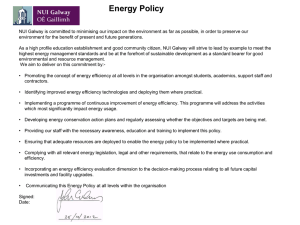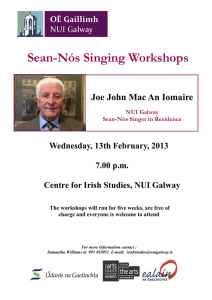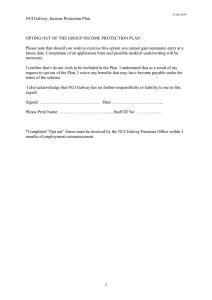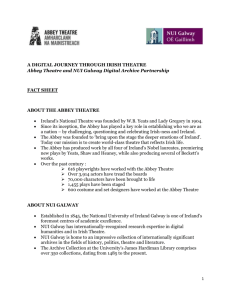Abbey Theatre Digital Archive Annual Project Report 2013 NUI, GALWAY
advertisement
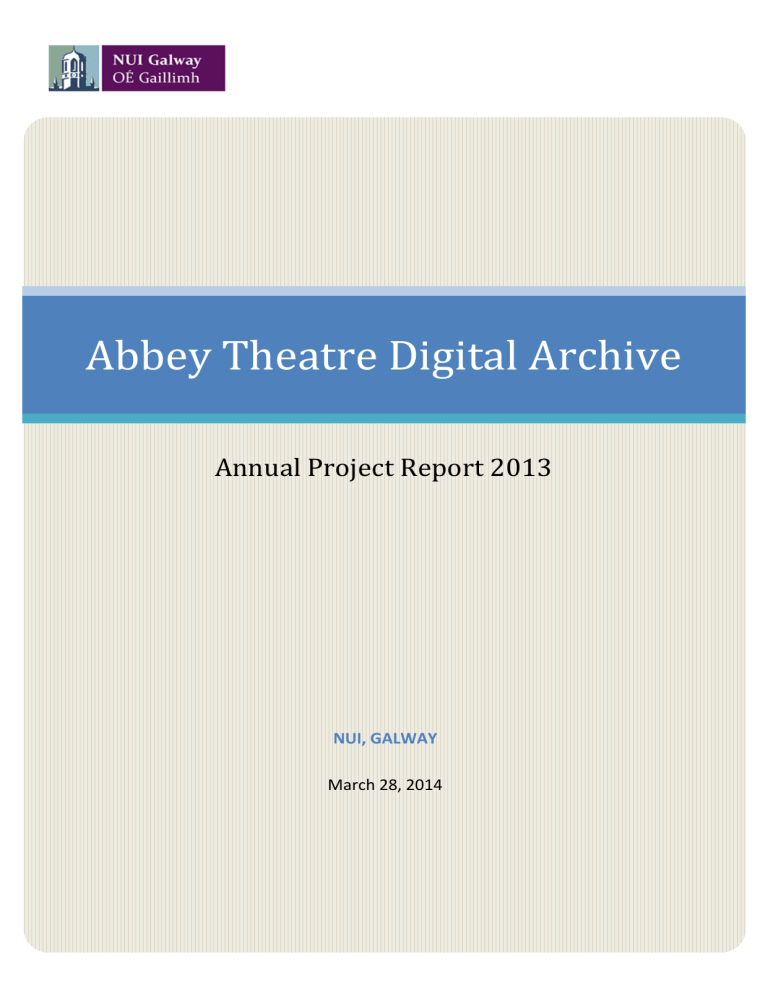
Abbey Theatre Digital Archive Annual Project Report 2013 NUI, GALWAY March 28, 2014 0 Introduction This is the first annual report of the Abbey Theatre Digital Archive project. It covers the period from 4 September 2012, when digitization commenced, to 31 December 2013. Reports henceforth will relate to each calendar year. National University of Ireland, Galway and the Abbey Theatre finalised a partnership to digitise the archive in April 2012. The partnership leverages NUI Galway’s position as a leader in theatre and digital humanities research and home to a range of theatre archives. The archive of the Abbey Theatre is one of the world’s major theatre archives, containing more than a million pages, 500 hours of video and 2500 hours of audio. The archival material ranges from show posters, programmes, photographs, minute books to lighting plans, set and costume designs, sound cues, prompt scripts and audio files. This is the largest theatre archive digitisation project ever undertaken worldwide. The project commenced in September 2012 and the retrospective digitisation will be completed in September 2015. It is creating a major international resource for research, teaching, learning in, and general public engagement with Irish drama, literature, history and many other disciplines. It addresses two particular challenges faced by the physical archive: preservation and access. The Abbey Theatre suffered a serious fire in 1951 which destroyed or damaged a significant amount of its holdings. This project will secure the current archive for future generations and will incorporate new material created during the term of the partnership between NUI Galway and the Abbey Theatre, which will continue until 2038. It also allows unprecedented levels of access on the NUI Galway campus to the archive which, until now, has been severely restricted due to space constraints and lack of cataloguing. The main work packages detailed in the project management methodology are: • • • • • Digitisation of the archive, according to recognised standards and including OCR output Cataloguing of items to international standard, enabling any item to be searched or related items browsed and linked Development of a systems infrastructure to publish the archive, automating to the maximum extent the observation of a range of rights management, redaction and embargo requirements Creation of a versatile user interface to support searching, browsing and linkage of textual data and related materials, enabling maximum discovery and user productivity Engagement of user communities with the digital archive, ensuring fullest exploitation through promotion, outreach and digital exhibition in the new NUI Galway Humanities Research Building This annual report details progress in the above areas, preceded by an overview of project governance and concluding with a preview of next steps. 1 Executive Summary Digitisation of the Abbey Theatre archive commenced at the James Hardiman Library in September 2012. The Abbey Theatre-NUI Galway Project Group is the key governance body and meets bimonthly to review and update project documentation. At the end of 2013, 308,195 unique pages had been digitised, of which 140,125 were available for consultation by researchers and 168,070 were withheld pending redaction or embargo expiry. Efficient workflows and systems have been developed to enable fast throughput with quality controls. The initial Abbey Theatre Digital Archive became accessible in the Archives Reading Room in the Hardiman Research Building on 2 December 2013. Users can search via a wide variety of terms and approaches, automatically generate citations for use in academic publications and interact with the archive in new ways. Particular attention has been given to digital rights management. Academic engagement has included new courses and programmes, PhD applications, research bids, internships at the Abbey, media engagement and public lectures. President Michael D. Higgins launched the project in October 2012 NUI Galway and the Abbey Theatre have developed a co-marketing plan which includes a major exhibition in 2014 as part of the launch of the Hardiman Research Building In both academic and archival circles, there is widespread awareness of and interest in the project in Ireland, the UK, and to an increasing extent, in the US. The major areas of focus for 2014 are on making further content available, enhancing the user experience and promoting awareness of and engagement with the resource. 2 Project Governance The Master Agreement documenting the partnership between NUI Galway and the Abbey Theatre provided for the establishment of a project group. This group met for the first time on 25 July 2012 and agreed terms of reference as follows: • To manage and progress the partnership between the Abbey Theatre and NUI Galway • To review the current Project Plan and update as required • To designate and review on an annual basis responsibilities within the Group for execution of the project plan • To monitor Intellectual Property Rights Management • To ensure the correct management of sensitive material in the digital archive, including the application of redaction policies and procedures • To review the digital rights management strategy and update as required • To manage the operation of the 30-year rule and to review documents for publication each year. • To promote public and scholarly engagement with the digital archive Meetings are held bimonthly, with the chair and venue alternating between NUI Galway and the Abbey Theatre. The Group in early 2013 agreed a project initiation document which sets out the project scope, deliverables and governance, along with a rolling project plan identifying the stages of the project, constituent tasks, parties responsible per task, incorporating start and end dates for each. This document, and in particular its project plan section, is reviewed and updated as required at each meeting, enabling progress to be monitored and future work identified. Members of the Project Group are: Abbey Theatre: Aideen Howard, Literary Director; Mairead Delaney, Archivist; Oonagh Desire, Director of Public Affairs and Development NUI Galway: John Cox, University Librarian; Patrick Lonergan, Professor of Drama and Theatre Studies; Caroline Loughnane, Director of Marketing and Communications; Professor Sean Ryder, Acting Director, Moore Institute (replaced by Dr. Justin Tonra, University Fellow in English, from September 2013) Mastermind Ireland Ltd: Martin Bradley, Archives and Records Management Consultant (engaged to provide project management) The Group formed subgroups as required for specific purposes during the reporting period. These subgroups focused on IT infrastructure; redaction/editorial function; and marketing and communications. Mastermind Ireland Limited (MIL) also provided written monthly progress reports to NUI Galway. 3 Project Progress Digitisation As of 31 December 2013, 308,195 unique pages of information had been digitised following two processes of weeding and removal of large quantities of duplicate material – firstly by the Abbey Theatre and secondly by archivists carrying out digitisation work. Of this material 140,125 pages were available for consultation by researchers and 168,070 pages were withheld pending redaction or meeting minimum time restraints for release (7/15/30 years depending on category and age of document). Included in the available material is pre-1950 archival content from the collections of the National Library. 18,882 pages of material comprising HR records and other data of a sensitive nature are “Closed” and will not become available during the lifetime of the agreement. The material captured to December 2013 breaks down into the following broad categories; Programmes: Prompt Scripts: Set Designs: Scripts: Lighting Designs: Audio: Venue Designs: Administrative Files: 31,413 pages 57,217 pages 1,341 pages 20,892 pages 10 pages 92 items 69 items 197,161 pages Metadata Where items can be linked directly to an Abbey Theatre Play Code or Production Code this has been done, which allows individual items to be searched by the full production history associated with each event (cast, crew, location, writer, covering dates) and associated with items which share any points in common (e.g. shared writer, set designer, costume designer etc). This allows easy and swift retrieval of items relating to specific search queries. Where it was impossible to link items directly to Play or Production Codes new metadata has been generated along with the ability to link to Plays or Productions that may be mentioned within the body of a file, but not the exclusive content of that file. All typescript items are also subject to OCR (Optical Character Recognition) as a third layer of searchability, which allows keywords to be searched across the entire content of the archive. Systems infrastructure All data are hosted on the Amazon S3 cloud storage service, as are instances of the Abbey Theatre Productions Database and the bespoke Digital Asset Management (DAM) system. This maximises system up-time as all maintenance is carried out by Amazon according to a defined service level agreement. It also serves to minimize outlay on servers and infrastructure, as it is anticipated that on completion total data storage requirements will exceed 40TB. 4 Aetopia Ltd., based in Belfast, was awarded to the contract to develop the user interface for the Abbey Theatre Digital Archive following a competitive process. The bespoke DAM which was developed following a lengthy process involving NUIG Staff, MIL and Aetopia is now available for use by researchers in the Archives Reading Room in the Hardiman Research Building. Users can search via a wide variety of terms and approaches, save items to a favourites folder, automatically generate citations for use in academic publications and interact with the archive in a way that was never before possible. Initial user response has been extremely positive. One of the key bespoke back-end systems developed was the capability to hold back material from release based on assigned categories and date ranges, and to detect and alert documents which contained ‘alert phrases’ and ‘alert individuals’ which will enable this material to be redacted (again using bespoke systems developed for this project) before publication. 5 Digital Rights Management All copyright material presented as part of the Abbey Theatre Digital Archive is being made available solely on campus at NUI, Galway under the provisions of Section 50 of the Copyright Act (2000) - Fair dealing with a literary, dramatic, musical or artistic work, sound recording, film, broadcast, cable programme, or non-electronic original database, for the purposes of research or private study, shall not infringe any copyright in the work. All users are required to agree to comprehensive Terms and Conditions at each log-in to the site, which cover acceptable usage, copyright, copying, permissions and access control. A log is maintained of every user, each search carried out, each document viewed and the times of each action. In the event of any breach it will be straightforward to pinpoint an offending user. Administration While technology proved a key focus, it is important to note that the establishment and ongoing progression of this project has required a range of administrative inputs, notably: Accommodation: The James Hardiman Library at NUI Galway established a project office to accommodate the MIL project team, its equipment and the original archival material transferred for digitisation by the Abbey Theatre. This office replaced a Postgraduate Study Room but offered convenient adjacency with the Library’s own digitization staff and equipment. Company regulation: In July 2012 NUI Galway set up a campus company, Lintary Ltd., in connection with the project due to a combination of requirements, including confidentiality (the project had not yet been made public) and the need to make a prompt start to the digitization in light of the fixed-term nature of the partnership. This made it possible to engage MIL to provide project management for a period of 12 months prior to the conduct of a full procurement process. The company required an amount of administration in compliance with Irish company law and the support of the Financial Accounting department at NUI Galway was invaluable. Procurement: The University conducted a full procurement exercise for archive digitization, cataloguing, publication and project management services for a two-year period from September 2013. Following a competitive tendering exercise, MIL was awarded this contract. Lintary Ltd is no longer involved with the project and will be closed down. Finance: The project is jointly funded until September 2015 at NUI Galway by the Registrar’s Office, the Research Office, the College of Arts, Social Sciences and Celtic Studies and the James Hardiman Library. The latter is accountable for managing the resultant budget. The main items of expenditure in the reporting period were monthly service payments to MIL, purchase of equipment, the development of the digital asset management system and cloud storage fees. The monthly costs of cloud storage increase as new data are added and will represent an ongoing cost for the University beyond the current funding period when the retrospective digitization is completed. Rights management: The Digital Rights Management requirements specified in the Master Agreement necessitated the development of a detailed statement of legal Terms and Conditions of Use to which all users must agree on login to the digital archive. The creation of a comprehensive statement and of a robust IT environment to prevent unauthorized use, supported by strict user registration procedures, required detailed engagement with legal, technology and archivist teams. 6 Academic Engagement During the reporting period, the primary academic focus has been on (a) building awareness of the project and (b) preparing infrastructure that will allow for the resource to be used, once it is made publicly available. Since the archive became available in late 2013, academic activities have necessarily increased and intensified. New Courses and Programmes A new postgraduate module on the Abbey Theatre Digital Archive was created and began enrolling students in September 2013. This module is directly providing engagement with the archive, and the intention is that students taking the course in the future will be encouraged to consider PhD research on the archive. This course is available to students on the MA in Drama (including the new part-time option which launched in September 2013) and Structured PhD students. A new Structured PhD in Drama and Theatre Studies was created, and enrolled its first student in September 2013. This Structured PhD will provide students with direct access to the Abbey archive, and provides training in archival research for all students. In October 2013, the Centre for Drama, Theatre and Performance put forward three new MA programmes for approval. These are an MA in Theatre Practice and Production, an MA in Irish Drama, and an MA in Writing for Theatre. The latter two are particularly relevant to the Abbey Archive, and again the aim is to ensure that students will be exposed to the archive at an early stage. At undergraduate level, First Year Drama tutorials now include a specific unit dedicated to archival research; students are brought to the new Reading Room by their tutors, where they are given information about the Abbey Archive and shown how to use it. PhD Applications In January 2013, seven people applied to the Irish Research Council to carry out PhD research on theatre at NUI Galway. Almost all of those applications were directly related to the availability of archival material on-campus, especially the Abbey material. One of the seven was successful; a second was funded under another scheme, and the remainder are either registered at NUI Galway or are applying again in 2014. This shows that, even at this early stage, the Abbey archive is already driving PhD recruitment, either by directly attracting students who wish to use this resource, or by bringing NUI Galway to the attention of ambitious young students. Early indications are that NUI Galway will recruit at least four PhD students on archives-related projects for 2014. Research Bids In the 2013 round of IRC project funding, NUI Galway submitted two bids for funding for projects related to the archives. Both projects were placed on the waiting list, which meant that both were very highly ranked. While neither was funded on this occasion, the high marks show that funding 7 for archives-related projects can be obtained; the researchers involved will apply again in 2014 with enhanced proposals. One of the bids was jointly prepared with Reading University and the Victoria and Albert Museum, providing the infrastructure for a future bid for European funding. Internships NUI Galway placed two interns at the Abbey Theatre during 2013. One worked in the archives; the other in the Literary Department. After completing her internship at the archives, one of the two students received funding to begin a PhD at NUI Galway, where she will work on the Thomas Kilroy and Abbey Theatre collections. Media Engagement Following on from the launch of the Abbey Archive, there was a steady and substantial level of interest from the national media, well into 2013. Academic personnel conducted interviews with The Irish Times, The Sunday Times, RTE (Morning Ireland), RTE (Six One News), and Newstalk’s Talking History programme. Public Lectures NUI Galway academic personnel gave talks on the Abbey archive at Queens University Belfast, Trinity College Dublin, and University College Dublin. Editorial Work One of the key academic functions related to the archive is the editorial work involved in redaction and also in advising on content. This represents a substantial ongoing commitment. Next Steps Now that the Archive is available for us in the new Hardiman Research Building, a major expansion of academic engagement is taking place. This includes: • • • • • • Recruitment of PhD students (two funded PhD scholarships advertised in February 2014). Publications (in preliminary talks about producing digital edition of the Abbey Theatre Minute Books). Embedding of Archive into teaching in Drama, Theatre and Performance. Further promotion of Abbey archive internally (to ensure take-up from colleagues in Languages, History, and other relevant disciplines). Further promotion internationally. NUI Galway staff will give talks on the archive at events at the Abbey Theatre (January 2014), SIBMAS New York (June 2014), American Conference for Irish Studies (June 2014), International Federation for Theatre Research (July 2014) and elsewhere. Networking. We have already begun to establish links with the Victoria and Albert Museum in London. This is the leading theatre archive in the UK. 8 • • Research proposals. In March 2014, NUI Galway personnel will attend an event in Oslo dedicated to digital theatre archives. This will allow for the development of new networks and new research proposals. Digital Applications. Much of the archival appeal of the Abbey Digital Archive is obvious, but the mass digitisation of documents at this scale offers a range of alternative research possibilities. Marketing Marketing of the Abbey Archive Digitisation Project began in October 2012 with the official launch of the project, and a new strategic partnership between the University and the Abbey Theatre. The launch, performed by the President of Ireland, Michael D. Higgins, attracted very significant national media attention across all media outlets. The focus of the launch was on communicating both a sense of the scale of the project – the largest theatre digitisation project in the world – together with the significance of the project in terms of preserving one of Ireland’s richest social, cultural, literary and political archives, and of expanding access to this national resource. For NUI Galway the launch helped to establish the University’s profile in both the field of Drama and Theatre Studies, and in the field of Digital Humanities. Post launch, NUI Galway and the Abbey Theatre have developed a co-Marketing Plan for the ongoing promotion of the Digitisation Project. In the initial three years while the digitisation takes place, marketing activities are focused on annual events to promote the archive. The first of these, since the launch event, will take place in May 2014 with the launch of the Hardiman Building. An exhibition of the Abbey Archive, featuring both the digital archive and items from the physical archive, will form the cornerstone of the Building launch. The theme of the exhibition, ‘From Page to Stage’, will highlight the diverse range of material included in the archive, from scripts to costume and set designs, to administrative records. The exhibition, designed by Dublin-based exhibition designers, Martello Media, will also highlight the historical links between the Abbey Theatre and the West of Ireland. As 2014 marks the 110th anniversary of the founding of the Abbey Theatre, this first exhibition of the Archive is expected to run for a number of months and will be promoted widely to tourists through PR, a dedicated brochure, video content and social media. It is also intended, through liaison with Fáilte Ireland locally, to link the exhibition to other relevant tourist destinations in the West of Ireland, such as Coole Park and Thoor Ballylee. Into the future, the conclusion of the digitisation project is anticipated to coincide with the 1916 Centenary celebrations and given the rich content in the Archive relating to that period, a major exhibition and full launch of the completed digital archive is proposed for Spring 2016. In addition to event-based promotion and PR, considerable profile for the project has been gained through attendance at and presentation of the project at a wide range of academic conferences in 9 both the Drama and Theatre Studies and the Digital Humanities and Library/Archives spheres. In both academic and archival circles, there is widespread awareness of and interest in the project in Ireland, the UK, and to an increasing extent, in the US. Other marketing initiatives to promote the project and the wider partnership with the Abbey Theatre include: Marketing Collateral • • • • • • Joint marketing collateral including display stands, on permanent display in the Abbey, and in the Hardiman Building A one-page NUI Galway advertisement carried in all show programmes where the Abbey Theatre is the producer of the programme NUI Galway has access to an allocation of theatre tickets for opening night and regular performance nights Abbey Theatre flyers for upcoming productions are now on display in prominent locations for staff and students on the NUI Galway campus and details of Abbey ticket promotions for staff included in internal ezines to staff A short brochure to promote the Archive Project for visitors to the Abbey and the Hardiman Building,will be developed to coincide with launch of Hardiman Building. Plans to produce a short video on the NUI Galway Archives Collection for the website for the launch of Hardiman Building, to include a major focus on the Abbey project Social Media • • Abbey Marketing Officer working with NUI Galway Online Marketing Officer to plan social marketing activity around the archive – currently using relevant items from the digital archive to highlight current shows at the Abbey NUI Galway Archives Blog developed by NUI Galway Archivist giving good visibility to the project - http://nuigarchives.blogspot.ie/ Other Activities • • The Digitisation Project is being promoted at other events at NUI Galway, including open days, conferrings, conferences, other significant University events ‘Meet the company’ events for key NUI Galway stakeholders are being explored, as are opportunities to link Foundation events in the UK and US with Abbey touring plans 10 Next Steps: 2014 and Beyond The major areas of focus for 2014 are on making further content available, enhancing the user experience and promoting awareness of and engagement with the resource. Maximising engagement has been identified as a high priority now that the digitisation workflows and processes have been established and access to the published digital archive initiated. Approaches identified include RSS feeds, social media, crowdsourcing, exhibitions and presentations at conferences and seminars in digital humanities and other fields. The development of further academic, archival and digitisation partnerships locally, nationally and internationally is also a priority through both external outreach and leveraging the excellent facilities of the Hardiman Research Building to host visitors and events at NUI Galway. The aim is to build on the strong connectivity already established with other organisations, notably the National Library of Ireland, the University of Manchester, the Victoria and Albert Museum, Princeton University and Emory University. ********************** 11
